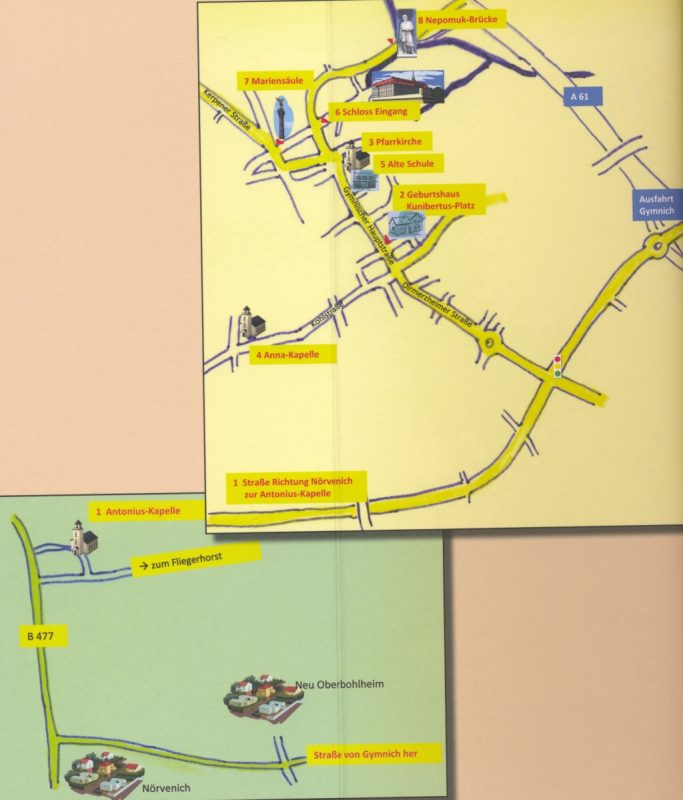Father Joseph Kentenich - Encounters with his Childhood in Gymnich
Pilgrim Guidebook
This Pilgrim Guidebook (printed edition available through Patris-Verlag) presents eight encounters with the childhood of Father Kentenich in Gymnich:
Saint Anthony’s Chapel (11 Km away)
view moreThe difficult way before his birth
view moreAt home with his grandparents
view moreThe parish and baptismal Church
view moreSaint Anne’s Chapel (Kohl Street approx. 1 Km towards west)
view moreThe School
view moreThe moated residence at Gymnich
view moreSigns of a Christian culture
view more
Depending on how much time you plan for your visit, you have the choice of several options. In any case it is worthwhile, firstly, to visit the house where Father Kentenich was born at Kunibertus Place and, whilst there, to view the video (approx. 40 min) on the childhood of Father Kentenich in Gymnich.
It is possible to conduct a religious service in the house of birth, and also in the Parish Church, after arrangement with the Parish Office.
Option A – Half day:
Chapter 2: Birth House
Chapter 4: Parish Church
Chapter 3: Birth House
Option B – Whole day:
Chapter 2: Birth House
Chapter 1: Saint Anthony’s Chapel (11 Km away)
Chapter 4: Parish Church
Chapter 7: Moated residence
Chapter 6: Place of the demolished school
Chapter 3: Birth House
Option C – Two days or an extended visit:
Time permitting, Option B, and in addition:
Chapter 8: Marian Pillar and bridge of Saint Nepomuk
Chapter 5: Saint Anne’s Chapel
The meditations are written in such a way so that any sequence is possible. Here you can see a general orientation map:
“The human soul is a wonderful creation.
No assimilated impression that has been engraved in you will be lost.
Sooner or later all these impressions will in someway set the human will, the human personality in motion.
You can imagine of what importance, for example, do our first impressions have on us as children.”
Fr Joseph Kentenich, Pedagogical Conference 1951
. . . preparing
Childhood
It is like moist clay, when someone moulds an image or a character. As long as the clay is still moist the inscriptions allow themselves to be worked on and to be changed. However, once the inscriptions have dried out and have been burned, an imprint remains.
It is similar with the childhood of a person. Those experiences, which a person has during the first years of one’s child-hood, yes, even already during the nine months of pregnancy, give the person’s life direction. Expressed in another way: In this time the script of one’s life is written.
Every person experiences in their childhood happy, but also depressing, encounters and situations. Nevertheless, life is not simply predetermined. It depends on what you make of life. It depends on how you deal in the course of life with the light and the shadows of your childhood. Whether you can engage in something new, face difficult situations and can be helped by others.
People of faith discover in the experiences of their childhood the start of a life journey that God lovingly accompanies them through joyful and difficult days. If a person has had a difficult childhood, the question is not: How could God allow such a thing? Even when we harbour many doubts, the actual question is: What does God intend with this person?
We may certainly also pose this question with regards to Father Kentenich’s childhood:
Well, what will become of this child? At a time when unmarried, pregnant mothers were ostracised and illegitimate children had few rights, little Joseph faced tough times. Nevertheless for him he had the love of his mother, the security that he could experience after initial problems in the house of his grandparents. And then there were all the small or intensive happenings that enriched and influenced life in a village-community at the end of the 19th century.
This Pilgrim Guidebook pursues some moments in Joseph Kentenich’s childhood. Experiences, which we are aware of, are placed alongside the views from the social and Church milieu of that period; but always in the background the question: What will become of this child?
Now about 130 years after his birth, we know what has become of this child. His biography, considered from today’s perspective, leaves us astonished, as to what a person can make of ones life and vocation when they recognise their roots and hand over their life to God.
So we are invited to follow those footprints Father Kentenich left behind in his hometown and at the same time to reflect about our own vocation.

 Deutsch
Deutsch Español
Español

